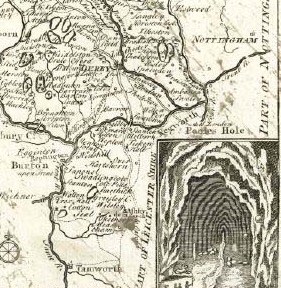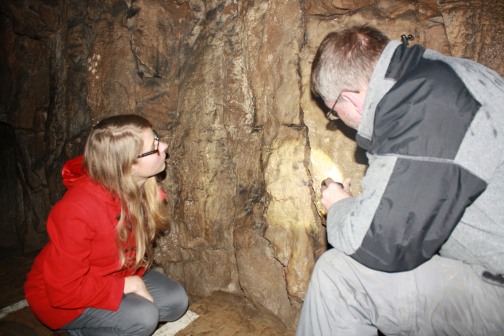Poole’s Cavern- A Wonder of the Peak
November 6, 2013 1 Comment
Many early tourists to Derbyshire would have known about Poole’s Cavern. It was one of the ‘Seven Wonders of the Peak’ and featured in Hobbes’ and Cotton’s work as well as being described by Celia Fiennes and Daniel Defoe. An engraving of the cavern interior was published in 1700 and it featured twenty years later on Moll’s 1720 map of Derbyshire.
The cavern opened as a show cave in 1853 and the entrance was enlarged to make passage easier. Prior to this the adventurous had to crawl on their hands and knees into the dark accompanied by local guides.The Beinecke Library possesses a commonplace book which contains four copied letters from an unknown man who visited Derbyshire in 1770. In his first letter he describes his visit to Poole’s Cavern.
‘The hole at which you enter into at the cavern is but very small & promises but little, however after advancing a few and creeping as close to the ground as you possibly can, you come to a chasm where you are shown Poole’s saddle and his Turtle, both of them good incustations’.
He describes the geological features including Poole’s woolsack, the lion, the lady’s toilet and the Fitch of Bacon. Most people would have turned back at the Queen of Scott’s pillar ‘so called by the unfortunate Mary when she visited this place’ but our unknown gentleman adventurer ‘with the spirit of curiosity, dared venture to the end’.
‘On however we went, the place was certainly very steep and craggy, and so slippery, that had it not been for fast grasps we should have never have been able to have got ourselves to the top. Here we stopped sometime in violent admiration a candle judiciously placed, without our knowledge, at the very extremity peeped like a star in a fine cloudy night, while another as properly set as the bottom whence he had ascended, had as singular and as aweful effect.’
Our unknown adventurer went on to visit the other subterraneous Wonders of the Peak; Eldon Hole and Peak Cavern. He was similarly as daring in these caves and he nearly came a cropper down Eldon Hole. His last letter describes his escapade down Eldon Hole and finishes with these impassioned lines;
‘…. And here my friend I will take my leave, the pain in my limbs are still excruciating but a little time will set all to rights again: all I have to say is, that I never wish even the greatest enemy I have in the world to be so unpardonly led by curiosity as to tempt destruction, where in despondent of the dangers of the place, the falling of a single stone might bury him in eternity for ever’.
In the twentieth century hundreds of archaeological artefacts were uncovered from Poole’s Cavern including Roman jewellery, Samian ware pottery and animal and human bones. A selection of these artefacts are on display in the Poole’s Cavern visitors centre and in the Wonders of the Peak Gallery at Buxton Museum and Art Gallery.



Pingback: The archaeology of Poole’s Cavern | Collections in the Landscape